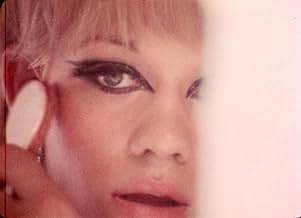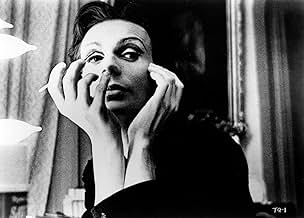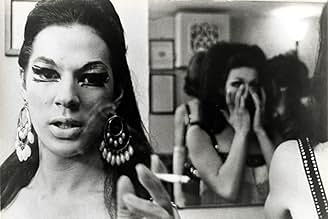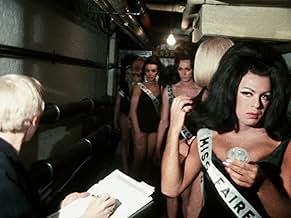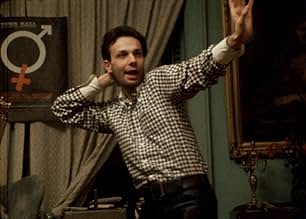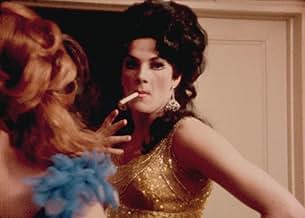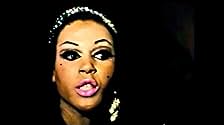CALIFICACIÓN DE IMDb
7.2/10
1.5 k
TU CALIFICACIÓN
El detrás de escena de un concurso nacional de drag queen en la ciudad de Nueva York.El detrás de escena de un concurso nacional de drag queen en la ciudad de Nueva York.El detrás de escena de un concurso nacional de drag queen en la ciudad de Nueva York.
Rachel Harlow
- Self - Harlow
- (as Richard Finnochio)
Opiniones destacadas
Don't judge this by today's standards where RuPaul wins Emmys and Pete Buttigieg is in the Cabinet. I am the same age as the guys in this film and was coming out as a gay man during the 1960's. Stonewall hadn't happened and there were ZERO gay role models. We can roll our eyes as these performers strut their not-so-spectacular stuff, and we're aware (as they are not) that AIDS will ravage. But give them their moment. They're bold and funny and, most of all, brave. At the time, they could be arrested for gay behavior, let alone ostracized and fired. It all kinds of glorious... for a night.
At New York City's Town Hall competitors for a national drag queen crown rehearse, bicker, and perform.
The quality of the performers ("Am I Blue" is a frequent choice for the song), and their costuming (sequins are very popular) ranges from pretty poor to excellent. The camerawork ranges from poor to objectifying to intimate) argue this is strictly amateur. The editing by Geraldine Fabrikant and Fred Shore sets the pace as dogged. The result is a movie that can be seen as a serious record of the event, a burlesque of beauty pageants, or a plea for understanding of drag culture. Unfortunately it never seems to choose one or another. It could have worked as all three, were it not for its technical failures.
Most likely, I am misinterpreting this movie. In all probability it was intended for the queer culture audience of the day, which would look upon its messages as clear, and its failings as hilarious. For me, it was a slog.
The quality of the performers ("Am I Blue" is a frequent choice for the song), and their costuming (sequins are very popular) ranges from pretty poor to excellent. The camerawork ranges from poor to objectifying to intimate) argue this is strictly amateur. The editing by Geraldine Fabrikant and Fred Shore sets the pace as dogged. The result is a movie that can be seen as a serious record of the event, a burlesque of beauty pageants, or a plea for understanding of drag culture. Unfortunately it never seems to choose one or another. It could have worked as all three, were it not for its technical failures.
Most likely, I am misinterpreting this movie. In all probability it was intended for the queer culture audience of the day, which would look upon its messages as clear, and its failings as hilarious. For me, it was a slog.
It's a behind the scenes documentary of a drag queen pageant in New York City. The contestants are all in the hotel facing many of the same struggles. They are desperate to pull their looks together. It's a great time capsule of a part of gay culture when most of it is still in the closet. It is letting the audience peek inside that closet and find some very nice gay boys. It's a year before the Stonewall riots. Gay rights is barely a talking point. It does need a main character and Richie is probably the best option. It would be nice to get some more in-depth conversations about their families and their present situations. In the end, it's already breaking down so many doors that it feels like I want too much from a simple documentary.
I got a rare chance to catch this film projected on 35mm film back in 1994 at the Castro Theatre in San Francisco. It was totally cool to see a reality slice of the NY underground drag world at that time, esp. before the Stonewall liberation riots. I highly recommend this film to anyone that is interested in underground cinema from the 60s thru the 80s. Its different than 'Paris is Burning' in that this film almost seems as though they decided to just put the footage together after it was shot and make a film. The footage is rough and shaky and most of the film is hand held. I think that this quality gives the film much more credibility as a true account of the times rather than one that was geared just to entertain the curious public. ANDY WARHOL makes a cameo appearance in one of the shots in the film as the camera pans onto the audience sitting down, THERE HE IS, sitting in a chair in the audience. Its very quick, so keep an eye out for his platinum wig!!! HIGHLY RECOMMENDED.
I've seen references to this film which incorrectly identify it as 'The Queens', plural, apparently referring to the participants as a bunch of "queens". The film's correct title is 'The Queen', singular, and I do mean singular. This is not a drag ball, in the style of 'Paris Is Burning' and other such affairs: this is a drag beauty pageant, with contestants vying in the knowledge that only one can be crowned: hence that title.
'The Queen' was bankrolled(?) by the late Lewis M Allen, elsewhere a Wall Street financier and Broadway producer, but you wouldn't know it from watching this movie. This is a no-budget documentary, and the cheapness and shoddiness of the production values make the subject matter look even cheaper and shoddier than necessary. I'm frankly surprised that this movie got made at ALL in the 1960s, and even more surprised that it received a general (not underground) release in 1968. Credit for the film's distribution -- spasmodic as it was -- goes to Grove Press, a publishing house notorious for issuing high-quality editions of 'Fanny Hill', 'Harriet Marwood, Governess' and other erotica of the past.
Beauty pageants in general don't much interest me, as I tend to find them demeaning ... and that goes regardless of the contenders' genders. In this movie, the sequence (sequins?) which I found most bizarre didn't involve cross-dressing at all. This was when one of the contestants, still in male attire, speaks to the interviewer in an epicene voice which falls precisely between the male and female registers. Then, suddenly, he bursts into song ... still in that same twilight register. Even more oddly, the song he's singing is 'Honey Bun', from 'South Pacific'. This is ostensibly a song performed by a macho sailor bragging about his curvaceous girlfriend, but -- as staged in 'South Pacific' -- it's actually a song written for a woman in male drag, singing about a man in female drag. I wonder if the singer in this movie intended those layers of gender-bending.
Any transvestites in the audience for this movie will probably glean some comfort from the fact that the cross-dressers shown here are (mostly) very ordinary-looking men -- overweight, balding -- with no special entree to feminine beauty nor daintiness. Any big hairy bloke who wants to look pretty has as good a chance as most of the males in this film.
For those of us not into beauty pageants, drag or otherwise, this film's major significance is historical. Among the people we see here is Richard Finnochio, now forgotten but once deeply notorious. Finnochio was the proprietor of a San Francisco nightclub which openly advertised drag acts, but which also booked stand-up comedians who were too edgy or raw to be able to get bookings elsewhere. Lenny Bruce honed his early act at Finocchio's.
Also seen here is an effeminate Latino boy named Mario Montez. I had assumed that this was a stage name, playing on MARIA Montez, a 'camp' actress who has a large gay following. I was wrong; according to the very minimal press kit for 'The Queen', that was his real name. Nice to know that something in this movie is genuine. (UPDATE: I was wrong twice; after posting this review, I received reliable information that Mario Montez was born Rene Rivera, and he did indeed name himself for Maria Motez.)
Towards the end of the film, there is some slight genuine suspense as we wait to see which of these would-be's will be crowned the queen. I shan't offer a rating for 'The Queen': it certainly does deserve one, but I'm probably not qualified to rate it objectively. Maybe this film broke some ground in 1968, but it has long since been eclipsed by far more outrageous sexual fare. Possibly that's a good thing. To anyone who thinks I disrespect the subject matter or the people depicted in this film: please note that I managed to get through this entire review without resorting to cheap wisecracks like "What a drag!"
'The Queen' was bankrolled(?) by the late Lewis M Allen, elsewhere a Wall Street financier and Broadway producer, but you wouldn't know it from watching this movie. This is a no-budget documentary, and the cheapness and shoddiness of the production values make the subject matter look even cheaper and shoddier than necessary. I'm frankly surprised that this movie got made at ALL in the 1960s, and even more surprised that it received a general (not underground) release in 1968. Credit for the film's distribution -- spasmodic as it was -- goes to Grove Press, a publishing house notorious for issuing high-quality editions of 'Fanny Hill', 'Harriet Marwood, Governess' and other erotica of the past.
Beauty pageants in general don't much interest me, as I tend to find them demeaning ... and that goes regardless of the contenders' genders. In this movie, the sequence (sequins?) which I found most bizarre didn't involve cross-dressing at all. This was when one of the contestants, still in male attire, speaks to the interviewer in an epicene voice which falls precisely between the male and female registers. Then, suddenly, he bursts into song ... still in that same twilight register. Even more oddly, the song he's singing is 'Honey Bun', from 'South Pacific'. This is ostensibly a song performed by a macho sailor bragging about his curvaceous girlfriend, but -- as staged in 'South Pacific' -- it's actually a song written for a woman in male drag, singing about a man in female drag. I wonder if the singer in this movie intended those layers of gender-bending.
Any transvestites in the audience for this movie will probably glean some comfort from the fact that the cross-dressers shown here are (mostly) very ordinary-looking men -- overweight, balding -- with no special entree to feminine beauty nor daintiness. Any big hairy bloke who wants to look pretty has as good a chance as most of the males in this film.
For those of us not into beauty pageants, drag or otherwise, this film's major significance is historical. Among the people we see here is Richard Finnochio, now forgotten but once deeply notorious. Finnochio was the proprietor of a San Francisco nightclub which openly advertised drag acts, but which also booked stand-up comedians who were too edgy or raw to be able to get bookings elsewhere. Lenny Bruce honed his early act at Finocchio's.
Also seen here is an effeminate Latino boy named Mario Montez. I had assumed that this was a stage name, playing on MARIA Montez, a 'camp' actress who has a large gay following. I was wrong; according to the very minimal press kit for 'The Queen', that was his real name. Nice to know that something in this movie is genuine. (UPDATE: I was wrong twice; after posting this review, I received reliable information that Mario Montez was born Rene Rivera, and he did indeed name himself for Maria Motez.)
Towards the end of the film, there is some slight genuine suspense as we wait to see which of these would-be's will be crowned the queen. I shan't offer a rating for 'The Queen': it certainly does deserve one, but I'm probably not qualified to rate it objectively. Maybe this film broke some ground in 1968, but it has long since been eclipsed by far more outrageous sexual fare. Possibly that's a good thing. To anyone who thinks I disrespect the subject matter or the people depicted in this film: please note that I managed to get through this entire review without resorting to cheap wisecracks like "What a drag!"
¿Sabías que…?
- TriviaJack Doroshow, who portrays Flawless Sabrina, made a personal appearance some years ago at a screening of this movie which took place at the Lincoln Center for the Performing Arts Library at Lincoln Center. In addition to the film, there was some soundless film footage presented of an after party which took place immediately after the contest, that footage which may have come from the personal collection of Flawless Sabrina. This footage shows that the NYPD "raided" the after party presumably because men dressing as women in those days was still illegal. Arrogantly and with no seemingly plausible reason, the police officers walked through the party requiring numerous attendees to show their identification, such harassing actions which could have arguably led up to the Stonewall rebellion of 1969.
- Citas
Self - Flawless Sabrina: I go up to this queen and I say, "What's your name?" The queen says, "Monique." And you say, "That's marvelous, darling, but what was your name before?" And the queen will look at you straight in the eye and say, "There was no before."
- ConexionesFeatured in God Save the Queens (1995)
- Bandas sonorasDiamonds Are a Girl's Best Friend
(1949) (uncredited)
Music by Jule Styne
Lyrics by Leo Robin
Performed by Mario Montez
Selecciones populares
Inicia sesión para calificar y agrega a la lista de videos para obtener recomendaciones personalizadas
- How long is The Queen?Con tecnología de Alexa
Detalles
Taquilla
- Total en EE. UU. y Canadá
- USD 47,818
- Fin de semana de estreno en EE. UU. y Canadá
- USD 7,173
- 30 jun 2019
- Total a nivel mundial
- USD 47,818
Contribuir a esta página
Sugiere una edición o agrega el contenido que falta


